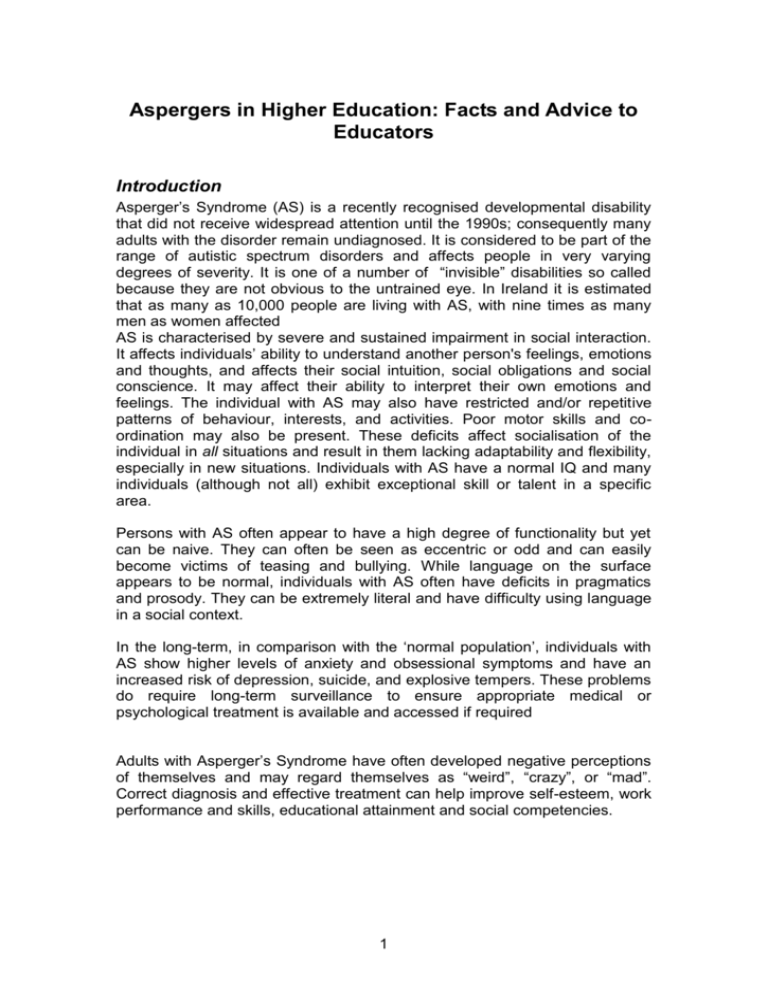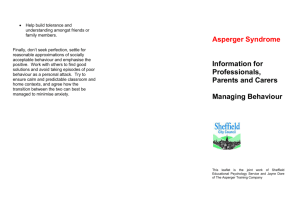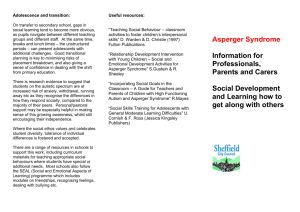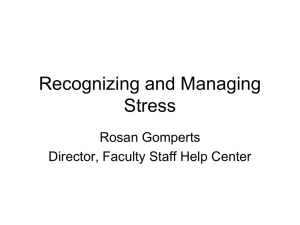Aspergers in Higher Education: Facts and Advice to Educators
advertisement

Aspergers in Higher Education: Facts and Advice to Educators Introduction Asperger’s Syndrome (AS) is a recently recognised developmental disability that did not receive widespread attention until the 1990s; consequently many adults with the disorder remain undiagnosed. It is considered to be part of the range of autistic spectrum disorders and affects people in very varying degrees of severity. It is one of a number of “invisible” disabilities so called because they are not obvious to the untrained eye. In Ireland it is estimated that as many as 10,000 people are living with AS, with nine times as many men as women affected AS is characterised by severe and sustained impairment in social interaction. It affects individuals’ ability to understand another person's feelings, emotions and thoughts, and affects their social intuition, social obligations and social conscience. It may affect their ability to interpret their own emotions and feelings. The individual with AS may also have restricted and/or repetitive patterns of behaviour, interests, and activities. Poor motor skills and coordination may also be present. These deficits affect socialisation of the individual in all situations and result in them lacking adaptability and flexibility, especially in new situations. Individuals with AS have a normal IQ and many individuals (although not all) exhibit exceptional skill or talent in a specific area. Persons with AS often appear to have a high degree of functionality but yet can be naive. They can often be seen as eccentric or odd and can easily become victims of teasing and bullying. While language on the surface appears to be normal, individuals with AS often have deficits in pragmatics and prosody. They can be extremely literal and have difficulty using language in a social context. In the long-term, in comparison with the ‘normal population’, individuals with AS show higher levels of anxiety and obsessional symptoms and have an increased risk of depression, suicide, and explosive tempers. These problems do require long-term surveillance to ensure appropriate medical or psychological treatment is available and accessed if required Adults with Asperger’s Syndrome have often developed negative perceptions of themselves and may regard themselves as “weird”, “crazy”, or “mad”. Correct diagnosis and effective treatment can help improve self-esteem, work performance and skills, educational attainment and social competencies. 1 DSM-IV (Diagnostic Statistical Manual) Diagnostic Criteria for AS A. Qualitative impairment in social interaction, as manifested by at least two of the following: 1. Marked impairments in the use of multiple non-verbal behaviour such as eye-to-eye gaze, facial expression, body postures, and gestures to regulate social interaction. 2. Failure to develop peer relationships appropriate to developmental level. 3. A lack of spontaneous seeking to share enjoyment, interests, or achievements with other people (e.g. by a lack of showing, bringing, or pointing out objects of interest to other people). 4. Lack of social or emotional reciprocity. B. Restricted repetitive and stereotyped patterns of behaviour, interests, and activities, as manifested by at least one of the following: 1. Encompassing preoccupation with one or more stereotyped and restricted patterns of interest that is abnormal either in intensity or focus 2. Apparently inflexible adherence to specific, non-functional routines or rituals. 3. Stereotyped and repetitive motor mannerisms (e.g. hand or finger flapping or twisting, or complex whole-body movements) 4. Persistent preoccupation with parts of objects C. The disturbance causes clinically significant impairments in other important areas of functioning. D. There is no clinically significant general delay in language (e.g. single words used by age 2 years, communicative phrases used by age 3 years). E. There is no clinically significant delay in cognitive development or in the development of age-appropriate self-help skills, adaptive behaviour (other than social interaction), and curiosity about the environment in childhood. F. Criteria are not met for another specific Pervasive Developmental Disorder or Schizophrenia. Common behaviours among persons with AS Aspergers Syndrome (AS) affects individuals uniquely. People with moderate to mild AS are most likely to have partners and children, and also are often able to hide their difficulties from people outside of the close family. Other individuals with AS will have significant social and communication difficulties. An individual with AS may display several or many of the following characteristics and to varying degrees: 2 Deficiencies in social skills, such as inappropriate social approaches, lack of empathy Difficulty realising when others are in trouble and need help Difficulty recognising the emotions, feelings and thoughts of others An inability to consider others' viewpoints Limited interest in friendships Difficulty with all aspects of communication: o Pragmatic language dysfunction o Difficulty reading non-verbal cues, interpreting and using body language, determining appropriate body space/distance o Limited ability in conversation o Takes language literally Difficulty in comprehension of meaning and social reasoning Difficulty with transitions and changes, resistive of change, rigid, preference for routines and consistency Obsessional traits Narrow range of interests/idiosyncratic special interests Overly sensitive to sounds, tastes, smells and sights Associated motor co-ordination difficulties Normal or above normal IQ Difficulty managing their own negative feelings, especially anxiety, anger and depression Adults with AS are susceptible to having various psychological difficulties. Often they are a result of the individual’s difficulty coping with their AS and the stress, anger, frustration, confusion, anxiety and fear that they feel. These additional difficulties are often misinterpreted, misdiagnosed, misunderstood and mistreated, especially if the underlying AS is undiagnosed or is not adequately understood. Some of the most common additional difficulties include the following: Anger outbursts (physical or verbal aggression, verbally threatening behaviour) Agitation and restlessness Increase in obsessional/repetitive activities/thoughts/speech Low mood / "depression" Apathy and inactivity Onset of uncharacteristic, bizarre behaviour or thoughts Increased movement difficulties Managing AS An understanding of some of the reasons why adults with Aspergers Syndrome are so vulnerable to psychological breakdowns is necessary in order to find appropriate solutions to assist in overcoming difficulties. The needs of each individual with AS are unique and need to be treated as such. There are over-riding good practice suggestions but ultimately educators need to be ready to deal with each student on an individual basis. The difficulties experienced are a complex interaction between an individual’s internal 3 characteristics relating to having Asperger’s Syndrome, and external factors relating to life events and experiences, adulthood, independence and expectations. The external factors which contribute to the difficulties include: No diagnosis and/or explanation No readily available group of reference Lack of understanding Asperger’s Syndrome and its implications in others Loss of routine, structure, occupation and external life plan Increase in independence Accumulation of experiences of failure Little or limited support networks Increased need for internal motivation and drive Increased self-awareness of limitations and differences Increased gaps between intellectual, cognitive skills and social, selfhelp skills. The internal factors include: Decreasing internal motivation Rigid ways of thinking Limited distractions from negative/obsessional thoughts Limited insight into own difficulties or reasons Poor coping strategies Low threshold for tolerance of stress, frustration and anger Poor self-identity, understanding and esteem What should educators provide? To manage, reduce and prevent further difficulties it is important to focus on underlying causes, which will be different for different individuals. The approach/intervention needs to be holistic with multi-dimensional strategies. Living Away from Home 1. Encourage advance visits to introduce student to campus, staff and facilities in order to lessen the impact of a new environment. 2. Ensure good liaisons between support service and home/carer 3. Assist student to gain on campus accommodation 4. Be aware of the incidence of depression among students with AS and be extra vigilant. Meetings with students with AS 1. Prepare a checklist of questions you need to ask the student and encourage them to do the same. 2. Avoid if at all possible cancelling and rescheduling appointments as this can cause a lot of anxiety for the student with AS. 3. Avoid distractions during meetings such as phones ringing or people interrupting. Students with AS have enough difficulty sustaining 4 4. 5. 6. 7. 8. concentration and focus in a social situations without dealing with distractions as well. Reduce background noise. Try to conduct meetings in quiet areas. When giving feedback be clear and direct, avoiding proverbs and euphemisms that a student with AS will not understand. Be careful using jokes as a student with AS may not understand it as a joke, but may take you literally Be sensitive and patient when questioning and listening and be prepared to rephrase. Merely asking a student to repeat an instruction will not ensure comprehension of that instruction. Assist students with AS to structure written presentations and with communicating ideas. Lectures 1. Provide typed lecture notes 2. Allow use of dictaphone 3. Explicitly outline whether course is fact or theory based. Examinations 1. Ensure practice with past exam papers 2. Allow student do practice timed essay. 3. Ensure an appropriate exam centre that is as much as possible free from noise, clutter and preferably not a large exam hall. Consideration should be given to those students with other sensory sensitivities such as to light and smell. 4. Ensure student has visited the alternate exam venue prior to the exam 5. Avoid the student queuing outside 6. Encourage students to plan their answers on rough paper 7. Encourage students to reread exam questions several times to aid comprehension. 8. Avoid “jargonising” exam questions, try keep to the point. Be clear and direct. 9. If possible avoid exposing the student to an invigilator walking up and down the room. 10. Allow the student to bring a familiar object into the exam hall with them for added security. Using the Library 1. If possible provide a quiet study room/area 2. Provide a contact person to aid with queuing for photocopiers etc Inappropriate Behaviour 1. Intervention around inappropriate behaviour should be consciousness raising rather than punitive. 2. Explanatory feedback should accompany any criticisms about behaviour. Encourage the student to question the rationale behind the criticism and to become explicitly aware of why the behaviour was inappropriate. 3. Language must be sensitively tailored. 5 4. It is not a good idea to assume that the student will automatically generalise from a specific to a class of behaviours 5. In cases where mutual understanding cannot be reached it may be necessary to get the student’s unqualified agreement that s/he will not engage in target behaviour again. 6. Do avoid constant disruptions in lectures from eager AS students ask them to make a list of questions that they think of during the lecture and tell them to raise them privately with the tutor/lecturer at the end of class. Other suggestions 1. Where there are subject choices to be made ensure that there is a member of the academic programme available to advise the student to ensure that they have an explicit understanding of the courses on offer, the contents of those courses and the routes those courses can take them. 2. Consider providing the student with a personal assistant especially fro the first number of weeks while the student is transitioning into third level. 3. Consider using a peer mentoring to support students with AS. (Be sure to inform the peer mentors about AS fully) 4. Ensure one contact person with the third level Disability Support office to ensure regular contact with the student and between the service and academic staff. If all the above is attempted you will reduce: Stress Boredom Anxiety Pressure Isolation Please address further enquiries to: Elizabeth Walsh Disability Officer Disability Support Service NUI, Galway Elizabeth.walsh@nuigalway.ie Acknowledged DSS, UCD for this information. 6









